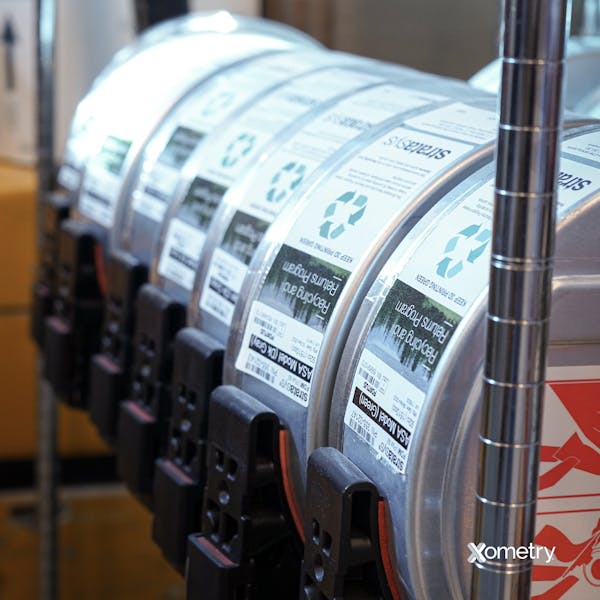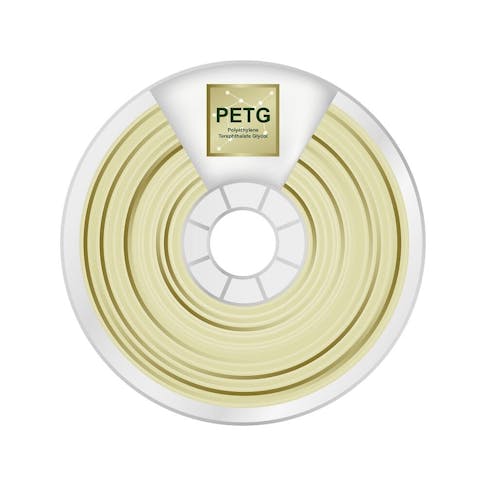Companies have no shortage of 3D printing types to choose from. A popular option that pops up on many manufacturers’ radars is 3D printing with polyethylene terephthalate glycol, more easily known as PETG. It’s often looked at as a method that offers a blend of the benefits found in ABS and PLA printing separately.
It’s commonly used in fused deposition modeling printing and is heralded for its food-safe characteristics. It’s helpful for many uses, but it can be tricky to extrude, so it’s worth learning about every facet of PETG.
What Is PETG 3D Printing?
This style of 3D printing uses PETG filament, which has a modified glycol molecule. It’s viewed as especially useful by print enthusiasts and professionals because it’s less likely to warp, it has high impact strength and low haze, and it’s pretty low cost compared to other types.
You can scroll through our 3D printing guide to get a better idea of whether PETG is the best method for your application or if there’s a better type of printer and filament out there. You can also see how PETG filaments look in a roll-up filament format in the picture below.

| Printer Setting | Configuration |
|---|---|
Printer Setting Extruder temperature | Configuration 220–260 °C |
Printer Setting Bed temperature | Configuration 70–90 °C |
Printer Setting Print speed | Configuration 40–60 mm/s |
Printer Setting Retraction speed | Configuration 35–40 mm/s |
Printer Setting Retraction distance (direct drive extruders) | Configuration 2–4 mm |
Printer Setting Retraction distance (Bowden extruders) | Configuration 5–7 mm |
Printer Setting Flow rate of filament | Configuration 95–100% |
Printer Setting Layer height | Configuration 0.28 mm |
Printer Setting Bed material | Configuration Polyetherimide (PEI) surface |
PETG Filament 3D Printer Settings
Wall Thickness and Density
It’s important to check the wall thickness you can achieve with PETG printing before you start using it to ensure it can provide the consistency and density you need. PETG is one such plastic with decent strength, so it’s possible to get around 0.8 mm to 1.6 mm in thickness with standard nozzles and around 2 mm to 3 mm with a larger nozzle.
You can also expect an infill density of 20%, which is how much of the material will get consumed during the printing process. At this level, it’s best for prototypes as it errs closer to the side of hollow in comparison to filaments with a 100% infill (which can create a solid product).
Properties and Composition of PETG
What makes PETG stand out from other 3D printing filaments? Its unique combo of characteristics includes good thermal stability and high chemical and impact resistance. It’s also safe enough to use around food and drinks. Although its print rate is a little bit slower than others, its benefits usually outweigh its cons.
Comparison to Other Filaments
If you’re wondering how PETG compares to other popular filaments, we’ve broken down some of the major differences in the table below.
| Property | PETG | ABS | TPU | PLA |
|---|---|---|---|---|
Property Fumes | PETG Non-toxic (but you still need proper ventilation) | ABS Toxic | TPU Non-toxic (but you still need proper ventilation) | PLA Non-toxic (but you still need proper ventilation) |
Property Hygroscopic | PETG Yes | ABS Yes | TPU Yes | PLA Yes |
Property Heated bed temperature | PETG 70–90 °C | ABS 80–110 °C | TPU 60–90 °C | PLA 20–60 °C |
Property Melting/extruder temperature | PETG 220–260 °C | ABS 210–250 °C | TPU 190–245 °C | PLA 180–230 °C |
Property Biodegradable | PETG No | ABS No | TPU No | PLA Yes, but it takes a long time — around 80 years |
Property Strength/impact resistance | PETG Very good, but it’s prone to scratches | ABS Good | TPU Very Good | PLA Average |
Property Recyclable | PETG Yes | ABS Yes | TPU Yes | PLA Yes |
PETG Filament vs. Other Filaments
Tips for Printing with PETG
To keep warping at bay and create the most impeccable prints possible, we’ve come up with a few helpful pointers:
- Keep the bed temperature within the right range for PETG (70–90 °C) as well as the extruder temperature (220–260 °C).
- Use the right hot end for your printer — for PETG, metal and PTFE inner tubes are both fine.
- Bring in a layer fan to help cool the layers of plastic faster, as this can also boost the quality.
- A glass print bed is great, but PETG is known to stick. Using something as commonplace as hairspray can help keep your bed safe and will help you remove the print more easily.
FAQs About PETG 3D Printing Filament
We’ve answered a few of the most common questions that come up when PETG printing is being considered.
What are the benefits of PETG printing?
Users like that PETG prints can be high quality and have better consistency, which can often be put down to the slower print rate. Its fumes aren’t toxic, especially in comparison to ABS, and it’s also a relatively strong thermoplastic. Its cheaper cost also makes it an attractive option.
What are the disadvantages of PETG printing?
There are a few things that might turn users off from using PETG. One downfall is that it’s extremely hygroscopic, which makes it hard to store. It’s also known for sticking to print beds, which causes some annoyance and can hurt the print integrity. PETG is also much harder to paint and post-process.
Is PETG easier to print with than PLA?
Users find that it’s more difficult to print with PLA in comparison to PETG. This is because PETG requires a hotter bed and extruder temperature. However, PETG does have a higher strength than its PLA counterpart.
How Xometry Can Help
We are big backers of 3D printing here at Xometry and provide numerous services under this umbrella, from plastic 3D printing to selective laser sintering to polyjet. Check out our website for more options and get a free quote.
Disclaimer
The content appearing on this webpage is for informational purposes only. Xometry makes no representation or warranty of any kind, be it expressed or implied, as to the accuracy, completeness, or validity of the information. Any performance parameters, geometric tolerances, specific design features, quality and types of materials, or processes should not be inferred to represent what will be delivered by third-party suppliers or manufacturers through Xometry’s network. Buyers seeking quotes for parts are responsible for defining the specific requirements for those parts. Please refer to our terms and conditions for more information.


